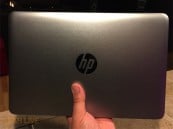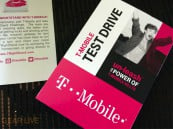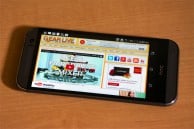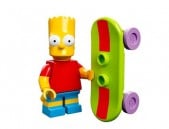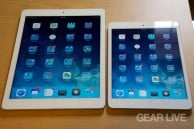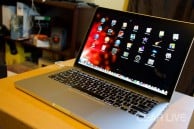Find Our Latest Video Reviews on YouTube!
If you want to stay on top of all of our video reviews of the latest tech, be sure to check out and subscribe to the Gear Live YouTube channel, hosted by Andru Edwards! It’s free!
Monday April 18, 2011 2:50 pm
The Blank Screen: How Apple Outsmarts Competitors

Posted by Andru Edwards Categories: Apple, Smartphones, Editorial, Features, Home Entertainment, Software

When the iPhone was launched in 2007, I met with Phil Schiller, SVP of World Wide marketing for Apple, and Greg Joswiak, the Apple VP in charge of marketing the iPods and iPhones. During the meeting they showed me the iPhone's many features and shared their goals for the device, which has now become a major business for Apple.
During that meeting, they made a comment that I believe is really the heart of Apple's secret sauce and the cornerstone of how it continues to outsmart its competitors. They laid the iPhone on the table, with it turned off, and asked me what I saw. I told them I saw a 3.5 inch blank screen. They said that from Apples point of view, the "magic" of the iPhone is strictly in the software. And, they de-emphasized the hardware.
Yes, the iPhone was a slick smartphone with a great screen and, at the time, it broke new ground in smartphone design, and Apple was very proud of that. However, with the iPhone turned off, it had very little value. But once it was turned on, the iPhone's OS and apps turned it into a completely different device. While it was a phone, the software made it much more—it became a vehicle for applications. It also had another component that really made it sing and dance; it was also an iPod and was tied directly to iTunes. Now it morphed into a much broader multi-purpose device. It was a phone, a vehicle for apps, and an iPod, which made it a great personal mobile entertainment system.
When Apple introduced the iPhone, it had not introduced the iOS SDK, and it gave no hint of what other type of "magic" software it had in store. But it's now clear that Apple had gone to school on the first PC software revolution and knew that if it could create a powerful SDK and put it in the hands of creative software developers, the software developers would create a diversity of apps that would give the iPhone its real value.
And that is what has happened. Using the SDK, software developers have delivered over 250,000 iOS apps and have also created a plethora of services tied to the iPad and iPhone. Of course, Apple's own iTunes services are the hub of Apple's offerings, but a multitude of applications are actually front ends to outside services as well, such as Netflix, Pandora, etc.
But it is this "blank screen" mentality that is most interesting about Apple's strategy. It literally sees software, not hardware, as its greatest value proposition and the one thing that keeps its competitors at bay. Yes, it creates great hardware. The new iPad 2 is sleek and, at the moment, the best of breed in tablet design. The iPhone also has a wonderful design that competitors try and mimic all the time. But, hardware is easily copied. Just look at the plethora of smartphones coming out these days. So many of them look like the iPhone, or try to one-up it with bigger screens and more bells and whistles.
Apple competitors delight in going head-to-head with Apple in hardware, because they can compete with them at this level. But it's the combinations of its hardware that's created specifically to be a vehicle for its software and the software itself that really sets Apple apart. And, there is another element to Apple's "blank screen" strategy that adds to its competitive advantage. It makes Apple driven content a cornerstone of its extended software offerings.
Apple's Software and Services Are Its Best Weapon
In fact, I believe Apple is about to make a major move that will distance it even more from its competitors. Apple has been working hard on creating a major data center in North Carolina that should be up and running soon. Simple logic says that a data center this size will be used for more than just running its music service. The new service that Apple will most likely start offering will be one focused on video on demand. I believe it has learned a lot from offering Netflix in its Apple TV program and will create a similar streaming video service with even more content than Netflix could ever gain access too.
I believe Apple has been courting all of the major TV and movie studios for some time and has been working to lock up all types of video content for its new offerings. In fact, it would not surprise me if Apple becomes the next powerhouse competitor to the cable companies, who are also trying to deliver more and more on demand content from their services. As is typical of Apple, it will probably be aggressive in delivering this on demand content across all of its devices—iPod, iPhone, iPad and Apple TV. That would mean that people could have their music and video on demand across all of these devices.
To be fair, Netflix does this pretty well now, as long as you have the Netflix app on similar devices. But Netflix's ability to gain access to stream first run movies when they go to DVD is non-existent. On the other hand, I believe Apple will offer these types of movies, as well as more content, because it can offer the studios an installed base of over 150 million devices that could play their content. As an even greater incentive to the studios, Apple most likely will only take a 30 percent management cut and give the lion's share of the profit back to the studios. I am hearing from my Hollywood contacts that while the studios fear Apple and Steve Jobs, they would be crazy not to use Apple as a major distribution arm for their digital content given Apple's audience.
While Apple employs a "blank screen" strategy when it approaches its product design, clearly its ultimate goal is to sell devices with apps and content as the draw. Apple has become so efficient in its supply chain management and manufacturing processes and drives such volume that it keeps its margins well above 30 percent. By comparison, its competitors are lucky if they can get 10 percent margins on their CE devices. A total package of hardware, software, and services together gives Apple an advantage that makes it hard for competitors to keep up with them.
That doesn't mean they won't try. Google and Amazon are both working on services that could try to match Apple's offerings. In Amazon's case, it doesn't have any control of hardware and can't really influence hardware designs to ensure that its hardware is optimized for its services as Apple can. And while Google should have more say over hardware design for Android devices, its open market approach leaves a lot of room for the hardware guys to design well beyond Android specs. This makes it more difficult to even get a single UI across all Android devices, let alone optimized versions of hardware that are designed to take maximum advantage of any new Google services.
Add to this Apples integrated advertising engine and you get a picture of what Apple's competitors have to deal with now and in the future. Apple uses software and services as its real competitive weapon, and in this case, it's a moving target for the competition, since Apple keeps innovating around software, as well as hardware. No wonder the financial market loves Apple. The more they study Apple's business model, they more they realize how difficult it will be for competitors to keep up with Apple.
This article, written by Tim Bajarin, originally appeared on PCMag.com and is republished on Gear Live with the permission of Ziff Davis, Inc.



